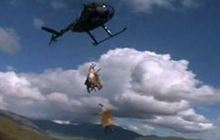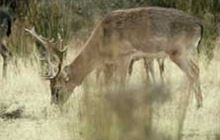Deer
Introduction
Learn about how wild deer are managed for conservation.People value hunting wild deer for sport and to harvest venison. But, unless their numbers are managed, wild deer can damage native plants - in some places they threaten how ecosystems function.
Seven species of deer have been established in the wild in New Zealand:
- Red deer (Cervus elaphus scoticus)
- Wapiti (C.elaphus nelsoni)
- Sika deer (C. nippon)
- Sambar (C. unicolor)
- Rusa deer (C. timorensis)
- Fallow deer (Dama dama)
- White-tailed deer (Odocoileus virginianus)
Get more information about deer species.
Current wild deer population
Wild populations of deer can be found throughout New Zealand. These animals are the descendants of deer that were imported and released from 1851.
Red deer is the most widespread species and is also the most commonly farmed deer.
A related deer is the wapiti, which occurs in northern Fiordland.
Fallow deer were introduced from 1860 and are now found in many low-altitude forests and rural areas, partly the result of farm escapes and illegal releases.
Sika, rusa and sambar populations occur only in the North Island. Sika live predominantly in the Kaweka and Kaimanawa Forest Parks in the central North Island, rusa in the Ikawhenua Range near Galatea, and sambar in the Manawatu and Bay of Plenty.
White-tailed deer live on Stewart Island and near Lake Wakatipu in the South Island.
Conservation threat
In New Zealand, deer have no natural predators. This means they can grow to large numbers without the support of hunters and others to aid in their management.
Deer populations have been building over the past couple of decades across the country. This is because they have been harvested at a lower level than their breeding rate. As numbers have increased, deer have moved into new areas to search for food.
Deer damage native forests by feeding on forest plants, trees, and seedlings. They start with the native plants they prefer most such as schefflera, broadleaf, and hen and chicken fern in forest understoreys. Then they will move on to plants they like less. This can result in large groups of deer mainly eating falling leaves from canopy trees.
In subalpine areas, deer can damage tall tussocks and wildflowers like alpine buttercups.
By targeting these plants deer can change their composition of plants. This takes vital food and shelter from other animals. Over time this can hinder or stop forest regeneration.
Managing wild deer to reverse these effects will help protect native species and increase forests' health and resilience in dealing with climate change.
DOC's work
DOC is responsible for:
- Managing populations of wild deer at priority DOC-managed conservation sites
- taking a leadership role across all land to ensure concerted action against the damaging effects of wild animals, including deer, on vegetation, soils, waters, and wildlife.
Our Wild Animals Management Programme aims to maintain or achieve wild-deer-free areas, prevent the spread of wild deer into new areas and manage their numbers elsewhere to reduce pressure on native plants and habitats.
Management
Management operations at place for wild deer can differ. DOC’s management approach and priorities are based on factors including:
- preventing deer from establishing in new areas
- the biodiversity value of a site – for example: the amount and types of native plants
- vegetation impacts
- other threats and pressures at a site – for example: the presence of possums or the risk of wild deer reinvading from neighbouring land
- feasibility of carrying out operations – for example: what is the terrain like, and how much might an operation cost
- other conservation activities happening at site.
Deer free areas
DOC works to maintain or achieve wild deer free areas at priority conservation sites. Some examples include:
- Working with Northland Regional Council towards achieving a Wild Deer Free Northland
- continuing to ensure islands in Fiordland and the Marlborough Sounds stay deer-free to protect unique native plants and habitats
- removing wild deer from Auckland, excepting the South Kaipara and Āwhitu peninsulas, in conjunction with Auckland Council
Managing populations
In other areas DOC works to try and manage numbers to reduce pressure on native ecosystems. For example:
- reducing deer numbers in the Raukūmara Ranges. Announced in August 2020, this is a partnership between Ngāti Porou, Te Whānau ā Apanui and DOC, funded by the Jobs for Nature programme. The partnership aims to restore biodiversity in the Raukūmara forest. Media release: Significant investment in Raukūmara Pae Maunga to prevent Raukūmara forest collapse, 11 August 2020
- preventing deer from dispersing through parts of Taranaki
- Kaimanawa Forest: DOC contributed funding to support a Jobs for Nature project with Sika Foundation to manage deer in the Kaimanawa Remote Experience Zone, which is approximately 15,000 hectares.
- Ruahine Forest Park: DOC is working to draft a deer management plan with the community.
Elsewhere, we encourage people to hunt by issuing free permits and allowing some commercial operators to harvest deer for the export venison trade. Get information about hunting deer.
Control methods
Aerial and ground hunting/shooting are the most common methods used for wild deer management or excluding them by fencing. DOC uses a combination of professional hunters and staff with highly trained indicator or bailing dogs for locating animals for removal.
Biosecurity measures are used to prevent further introductions and spread of introduced wild deer and remove incursions. Biosecurity work could include compliance checks for deer farms, or carrying out eradication checks on land that is meant to be free from wild deer. It is illegal to liberate deer into the wild without a DOC permit – the penalty is a $100,000 or up to 2 years in prison.
Research and monitoring to understand population trends, and the impact on plants and ecosystems are also important tools in wild deer management and used to inform where management occurs.
Wild Animal Recovery Operations (WARO)
DOC also administers concessions for WARO on public conservation land to enable deer to be commercially recovered for processing into venison and by-products. Read more about Wild Animal Control Operations
Deer farming
DOC is responsible for regulating deer farming under the Wild Animal Control Act 1977.
Fine out more about deer farming requirements in the:
Monitoring your control
All operations require monitoring. Learn more about monitoring.
Faecal Pellet Index (FPI)
This is a method for estimating the abundance of deer. It is based on counts of faecal pellets along randomly placed transects. It involves counting deer pellets in small circles along a large number of short lines positioned randomly in the block.
View the Protocol for estimating changes in the relative abundance of deer in New Zealand forests using the Faecal Pellet Index (PDF, 800K) (opens in new window) which explains the methods further.
You can help
DOC cannot do this work alone - wild deer are present throughout the country on both public and private land, with significant numbers in some places.
Hunters, landowners, and other agencies can contribute to wild deer management. Through working together, we can make a bigger difference for nature.
If you encounter a wild deer in an area that DOC is working to keep goat free, report it at wildanimalmanagement@doc.govt.nz.
If you are a hunter and can safely remove wild deer, please do so. You only need to report it if the deer is in an area that is meant to be deer free.
Te Ara Ki Mua framework
Te Ara Ki Mua framework is a national framework designed to guide the collaborative effort needed to reduce browsing pressure on our environment from wild deer, pigs, goats, tahr and chamois. It describes actions hunters, landowners, and other agencies can take to achieve the goals of Te Mana o Te Taiao Aotearoa New Zealand Biodiversity Strategy.
Northland and Auckland deer sightings
If you spot wild deer in the Northland region, call 0800 FIND DEER (0800 346 333). This hotline is funded by DOC and the Northland Regional Council.
If you spot wild deer in the Auckland regions, call DOC’s Warkworth office +64 9 425 7812 and let us know.
Signs deer are present
The size and shape of the faecal pellets varies slightly between the species of deer, but generally the black or dark brown faecal pellets are deposited in groups, and are often elongated with one more pointed end. Likewise the footprints vary, but show two pointed toes.
Stags preparing for the rut thrash shrubs and saplings, sometimes completely ringbarking young trees. Wet or dry wallows are used by both sexes, when they are shedding their winter coat or during the rut. Flattened leaf litter or short ground vegetation indicate bedding sites. Deer often make trails through the bush for travelling and feeding.


